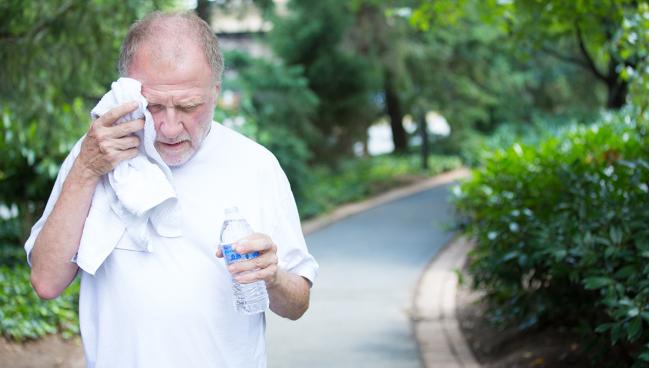As Temperatures Soar, So Do Cardiovascular Deaths
Extreme heat was linked to increased CV mortality, with higher relative risks seen in the elderly, men, and Black patients.

Rising temperatures are associated with more deaths from cardiovascular causes, but the effects of extreme heat are not shared equally by everybody, according to results from a new longitudinal analysis.
Between 2008 and 2017, extreme heat in the United States was responsible for roughly 6,000 excess deaths from cardiovascular causes, and it was the elderly, men, and non-Hispanic Black people who were hit hardest by the red-hot temperatures.
It’s also a critical reminder that scorching summer days claim a toll beyond conventional heat-related illnesses, say researchers.
“I think there’s probably been an underappreciation of the health effects of extreme heat, particularly among the cardiology subspeciality,” lead investigator Sameed Ahmed Khatana, MD, MPH (University of Pennsylvania Perelman School of Medicine, Philadelphia), told TCTMD. “This isn’t something that’s well appreciated in our field. Some people who work in fields like emergency medicine do see people coming in with heatstroke and heat exhaustion, but other specialties are less aware of the effects of extreme heat.”
The idea for the study, published June 21, 2022, in Circulation, sprung from the 2021 heat wave that affected large swaths of North America, specifically regions of the western United States and Canada, said Khatana. That heat wave, he noted, was so extreme it buckled roads and melted power lines in addition to causing extensive forest fires. While most physicians are aware that such temperatures are harmful to human health, what’s less well known is that heatstroke per se is responsible for only a small number of heat-related deaths, with other physiological responses also having lethal effects.
While patients with cardiovascular disease or risk factors might be particularly vulnerable, there are few data on how extreme heat affects cardiovascular mortality. “There are some studies that have looked at particular cities or extreme-heat events, but nothing that has really captured the whole country,” said Khatana.
Effects of Extreme Heat Not Evenly Felt
In the new study, extreme heat was defined by temperatures that were significantly higher than usual for all 3,108 US counties based on maximum heat index levels from the Centers for Disease Control and Prevention’s environmental public health tracking program. Extreme heat for each summer day was identified if the temperature was 90°F (32.2°C) or higher and in the 99th percentile of the maximum heat index based on the baseline period (1979 to 2007) for that day. County-level, age-adjusted mortality rates were based on data from the National Center for Health Statistics.
Overall, there were 3,139,134 CVD deaths among adults during the summer months (May to September) between 2008 and 2017, yielding a median of 89 extreme-heat days in the contiguous US as a whole. Counties were then stratified according to the median number of extreme-heat days, yielding a median of 45, 90, and 133 extreme-heat days in tertiles one, two, and three.
For counties in the first tertile of extreme-heat days, the population-weighted median monthly cardiovascular mortality rate was 22.8 per 100,000 individuals. In the second and third tertiles, the rates were 24.9 and 26.2 per 100,000, respectively.
In a fixed-effects regression model, each extreme-heat day per month was associated with a 0.12% higher monthly cardiovascular mortality rate and 3.14 additional deaths per 10 million adults. Put another way, extreme heat in the contiguous US was responsible for an estimated 5,958 additional cardiovascular deaths in the summer months between 2008 and 2017. When less-strict definitions of extreme heat were used, that number rose to more than 7,000 excess deaths.
Data also showed that the burden of extreme heat-related cardiovascular mortality wasn’t evenly distributed across the entire population. For example, there was a larger relative increase in cardiovascular mortality rates among men versus women, among non-Hispanic Black adults compared with non-Hispanic white adults, and among the elderly versus younger adults. Additionally, the researchers saw differences in the strength of the association by US regions.
“Areas that had the least number of extreme-heat days actually had the strongest association between extreme heat and mortality,” said Khatana. “That potentially suggests that areas that aren’t used to having extreme heat events might not be as well adapted. When extreme heat does occur, there might be perhaps a greater increase in the risk of cardiovascular death. It suggests that those areas might need to start preparing for extreme-heat events, which are occurring more and more frequently than before.”
Body’s Thermoregulatory Response
Last month, the same researchers published a similar study in JAMA Network Open showing that extreme heat was associated with higher risks of all-cause mortality. From a physiologic perspective, Khatana noted that the cardiovascular system is an integral part of thermoregulation. In an extreme-seat situation, blood is pumped to the periphery to dissipate heat, but in people with preexisting cardiovascular disease or risk factors, the excess strain on the system makes them vulnerable to adverse events, such as MI or stroke.
“We also know that certain cardiovascular medications, such as beta-blockers, can also affect the body’s thermoregulatory response,” said Khatana. Diabetes, too, can impact the ability to regulate body temperature.
In addition to the physiological response, there are possible structural and environmental factors that could explain some of the disparities seen in the study. Minority populations, including non-Hispanic Black adults, are more likely to live in areas that experience an “urban heat island effect,” which means that built environments, which have less tree cover, among other things, are hotter than surrounding rural areas, said Khatana.
One recommendation for healthcare providers is to be aware of patients who might be particularly vulnerable to extreme heat, such as the elderly or those with cardiovascular disease. Asking if they have access to air-conditioned spaces would be a good idea, and if they don’t, the next question would be if there are cooler spaces they could go when the temperature soars.
“Hospitals and providers also need to work with policymakers to come up with local solutions,” said Khatana. “It doesn’t have be a big national or global thing, which we obviously need for climate change, but something to make sure your local community or neighborhood has an extreme-heat plan. If there are cooling centers set up, do people know how to get to them in the neighborhoods where people are particularly vulnerable? Healthcare providers can play an important role in that by talking to their lawmakers and policymakers and highlighting that this a major health issue that will continue to grow in the coming decades.”
Michael O’Riordan is the Managing Editor for TCTMD. He completed his undergraduate degrees at Queen’s University in Kingston, ON, and…
Read Full BioSources
Khatana SAM, Werner RM, Groeneveld PW. Association of extreme heat and cardiovascular mortality in the United States: a county-level longitudinal analysis from 2008 to 2017. Circulation. 2022;Epub ahead of print.
Disclosures
- Khatana reports no relevant conflicts of interest.





Comments